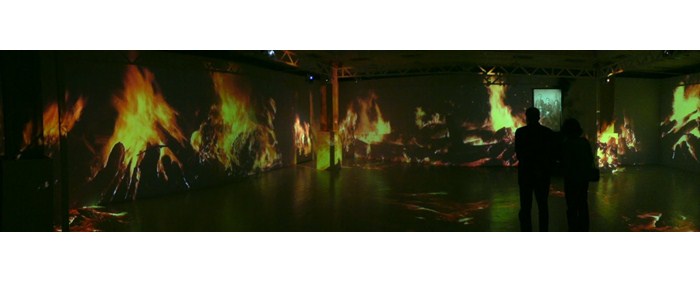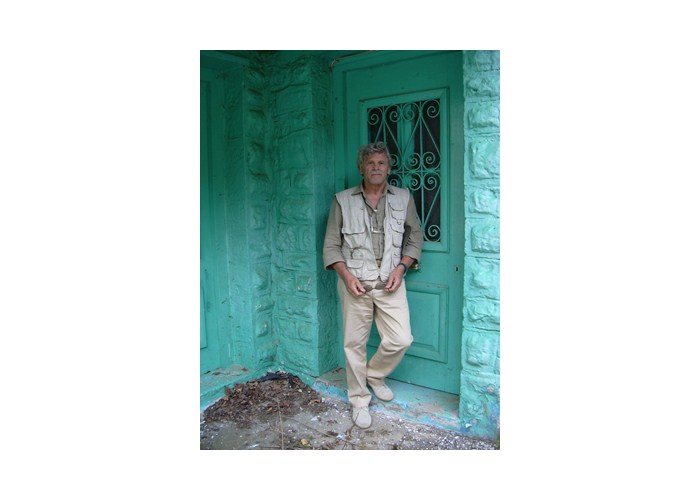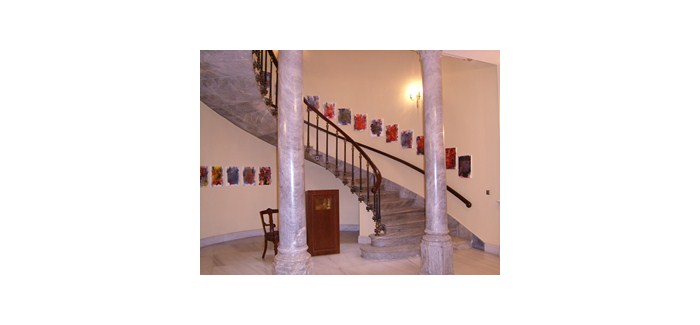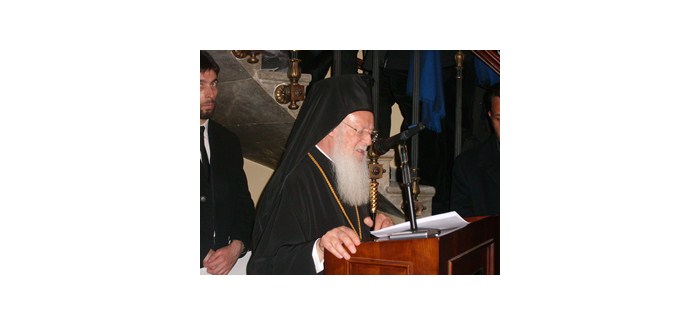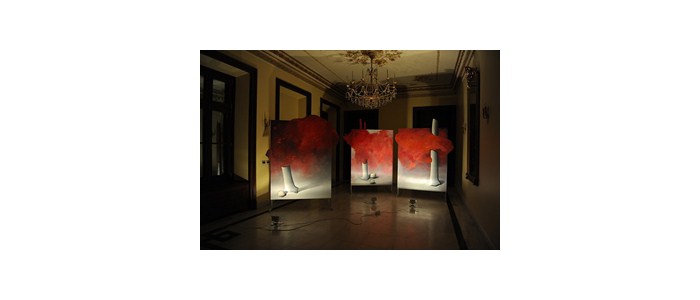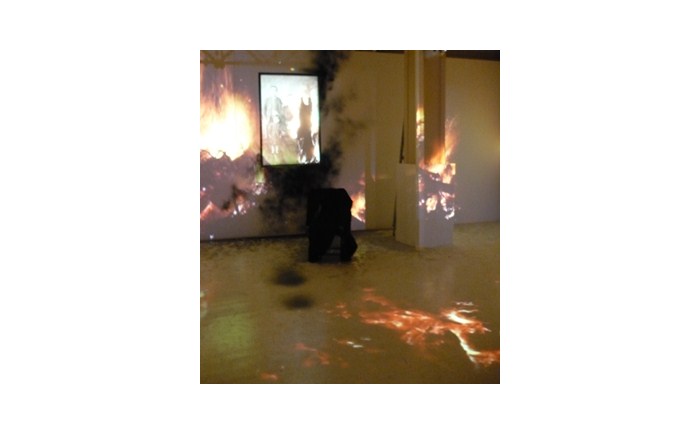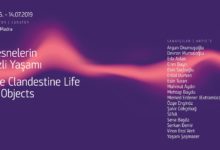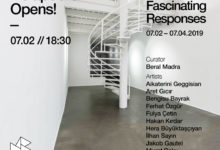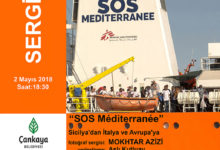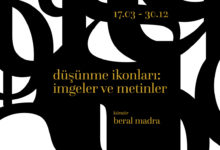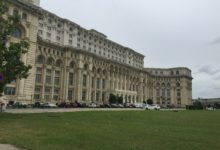TSOCLIS
“PROMETHEUS’UN İHTİYATSIZLIĞI” (PROMETHEUS IMPRUDENT)
25 MART/MARCH-23 MAYIS/MAY 2010
SISMANOGLIO MEGARO, ISTANBUL
Küratör/Curator: KATERINA KOSKINA
Yunan Devlet Çağdaş Sanat Müzesi Yönetim Kurulu Başkanı/President of the Board of trustees of the State Museum of Contemporary Art, Greece
Video: Hronis Pehlivanidis
Mimar/Architect: Yorgos Triandafilu
Proje/Project:Istanbul 2010 AKB Görsel Sanatlar Yönetmenliği/ECOC Visual Arts Directorate; Yunanistan Cumhuriyeti Istanbul Başkonsolosluğu/Consulate General of Greece in Istanbul; Yunanistan Devlet Çağdaş Sanat Müzesi/State Museum of Contemporary Art, Greece
CATALOGUE TEXT
“FIRE DILEMMAS”
Beral Madra
Being born and living in the Mediterranean region is a privilege. Despite the fact that globalization, science and technology are blurring the natural and historic distinctions between regions and that global political relations are mauling the region, the features of its geographical and historic texture and of its culture strata make people feel privileged. We can clearly see the relics of this feeling when we view the works of the contemporary artists of the Mediterranean region. In such works we observe the tendency to break the rules of 20th century modernism and those of the late century postmodernism; yet along with these tendencies, all the geographical, historical, traditional and mythological memory of the region is somehow expressed. In the inextricable relation of the artists with the globalized world, discredited with everyone, there is a need to reflect a relative confidence via the arts. This need is met by wending a way towards the basics and roots. Countless elements supporting this need are still found in the region.
The Aegean Sea stands as a second privileged environment. Greece and Turkey, two countries –interconnected through deep historic realities – of the Aegean region, subsisting invaluably despite the interminable negative impacts of global capitalism, are expending significant efforts to heal the concussions and resentments created by the nation-state attitudes of the 20th century with models of political, economic and cultural relation suitable to the global environment. This healing is handled in several ways by the different segments of the two societies. In the context of the rules and standards of the EU, political relations have ups and downs parallel to the discourses and interests of the political parties of the two countries, while the economic relations present a rather imperturbable air. The most productive and firm of these relations, cultural relations are built and fortified by creative individuals. Even at times of high tension between the two countries, these relations have proved to be strong.
Discourses like intercultural interaction and cultural nomadism, prevailing in art circles, along with the cultural and artistic exchange among neighboring countries in the pursuit of new art markets have come to influence artists of both countries. Artist meetings, formerly hindered by the political environments during modernist and late-modernist periods were finally initiated in early 90s, when artists started to visit one another in Istanbul, Athens and Thessaloniki. The group exhibition opened under the curatorship of Efi Strousa in the Istanbul Biennale in 1989 stands out as the starting point of this process. Realized straight after this first exhibition, Sanat Texhni (1991), which covered the work of 14 Turkish and Greek artists, fortified awareness and the necessity of gathering.
One of the most impressive works of these cultural efforts by Turkey and Greece was presented by Costas Tsoklis in March 2003 at Tophane-i Amire Culture Center under the title Resurrection. The main theme of Tsoklis’s exhibition covered old family photos of Greek people who had lived in Turkey in 1920s and later migrated. With respect to its content, this space arrangement, peculiar to Tsoklis, a composition of photographs, paintings and videos, was a reference to the collective memory of Turkey and Greece, especially in relation to the context of political and social events of the early 20th century. Meanwhile, concerning its style it was an interesting solution to the problem of the synthesis of different art techniques. Such photographs are the only tools of memory left in the hands of all the Anatolian families who were uprooted from their homeland in the first half of the 20th century. They also mirror the family structure and culture of their time.
With this exhibition, Tsoklis not only built an individual dialogue with Turkey, he also responded to a responsibility formed through collective memory. Mihail Bakhtin defines this kind of artistic responsibility as follows: “However, this relation is not cognitive and not ethical: the artist does not intervene in the event as an immediate participant in it, for then he would become someone who is engaged in cognition and who acts ethically. The artist assumes an essential position outside the event as a contemplator who is disinterested but who understands the axiological sense of what is coming to pass – as a contemplator who does not experience the event but co-experiences it, for, without co-evaluating to some extent, one cannot contemplate an event as an event specifically.” (1)
Isn’t this one of the most distinctive characteristics of today’s art? Keeping memory alive and assessing global events collectively stand out among the functions of art. Even if the exhibition displaying these images opened during the healing process in the relationship between Turkey and Greece reflected the gloom of a lost past, it also helped overcome the challenges of confronting that history. Like all the artists dealing with history and memory, Tsoklis undertakes both research and aesthetical synthesis in order to express his interpretations and thoughts. Even though what is signified does not signify a memory per se, there is scientific and technical evidence in this aesthetical synthesis. This is an outcome where the organizing power of knowledge and experience unite with the isolating power of aesthetics.
Similarly, in the exhibition entitled Prometheus Imprudent we observe other processes of this method and confrontation. This time, the viewer meets with Tsoklis’ installation at Sismanoğlu Building. Stretching over the three floors of the building, the exhibition is comprised of paintings of fire with Turkish texts, video images and three sizable photographs. Here, Tsoklis writes a visual legend on Prometheus and fire while bringing up the topic of the spirit of the time, as usual: the need for reassessing our relationship with nature, history, science and technology by using collective knowledge under present circumstances…
Despite the fact that science and technique have already ruled out the belief that the world is made of merely fire, water, earth and air, we should admit that these four symbolic elements continue to be mentally and emotionally valid on cultural and individual levels. From among them, Tsoklis picks fire; for its symbolism and visual values serve his purpose. Tsoklis’s purposes are a close-fit to the definitions of fire by Gaston Bachelard from The Psychoanalysis of Fire: “Fire is thus a privileged phenomenon which can explain anything. If all that changes slowly may be explained by life, all that changes quickly is explained by fire. Fire is the ultra-living element. It is intimate and it is universal. It lives in our heart. It lives in the sky. It rises from the depths of the substance and offers itself with the warmth of love. Or it can go back down into the substance and hide there, latent and pent-up, like hate and vengeance. Among all phenomena, it is really the only one to which there can be so definitely attributed the opposing values of good and evil. It shines in Paradise. It burns in Hell. It is gentleness and torture. It is cookery and it is apocalypse. It is a pleasure for the good child sitting prudently by the hearth; yet it punishes any disobedience when the child wishes to play too close to its flames. It is well-being and it is respect. It is a tutelary and a terrible divinity, both good and bad. It can contradict itself; thus it is one of the principles of universal explanation.” (2)
This definition gives clues about this work he has built on fire. Tsoklis views fire not as a fact of nature but as a social and mental experience and examines it with its pros and cons. For Tsoklis, fire’s characteristics – not only illuminating but also burning, shattering, tutelary and terrible – serve as convenient tools with which to think about the dilemmas and conflicts of today’s world.
The collective positive thoughts about fire lead us to mythology and habitually we can relate substantial information concerning Prometheus’s story; although we are aware that such information has turned into a cliché nowadays… However, underneath this cliché lies an unwavering truth about our existence: the question whether civilization would ever be possible without fire always remains solid . Looking on the bright side, Tsoklis cites fire as an appearance which can present goings-on as an ideational and imaginary experience in a rapidly changing world order. This source of light and energy is masculine and active and symbolizes the conscious. This, in turn, makes reference to collective activity and consciousness that societies can be expected to show in relation to common global problems, despite all the challenges they may face.
Prometheus’s privilege was to be forethoughtful, as indicated in his name. He was one of the demigods, who were entitled to share in the power as long as they agreed to obey the orders of Zeus. Being forethoughtful justifies his rebellion. Prometheus turns his rebellion into action when he steals a flame from the fire of the sun on Mount Olympus and takes it down to the dark and cold earth. As a consequence of his action, he is forced to put up with an eagle eating his liver, which grows back every single day. Even under these circunstances, he does not give up questioning the order. Despite this optimistic and traditional belief, Tsoklis finds Prometheus rather imprudent. Clearly, there are grounds for this satirical attribution. Maybe, it is based on the Prometheus Complex, defined by Bachelard: “all those tendencies which impel us to know as much as our fathers, more than our fathers, as much as our teachers, more than our teachers.” (3)
Should this tendency to self-confidence have a limit? Could the desire/hope of changing the order impede one’s ability to see the truth? Are these audacious characteristics of Prometheus still applicable in today’s world? Did Prometheus foresee the consequences of changing the order? Can the ones who change the order always succeed? Do the artists act like Prometheus? Or is there an order impeding them from being like Prometheus? Such questions find answers in the texts of the fire paintings. And those who watch the fire documentary observe Prometheus’s imprudence and passion for changing the order in the dilemmatic presence of fire.
In art history, a close study of paintings of fire reveals that these works usually depict urban or vessel fires. One of the interesting paintings showing fire directly is by Antonio Vivarini of Murano (1440-1450). It depicts the miracle of St. Petrus the martyr in front of the Sultan (Berlin Gemaelde Galerie). Another fire and flame painting, an extraordinary work for its era, is by Giuseppe Arcimboldo. This portrait entitled The Fire is a component of the Four Elements series (1556, Kunsthistorishes Museum, Gemäldegalerie, Vienna). As a third example, we can take Heinrich Füger’s neoclassical work entitled Prometheus Brings Fire to Mankind (1817). In these symbolic works, we see the artists’ efforts to mirror the mythological, civilizational, mystical and religious connotations of fire. Tsoklis, on the other hand, takes fire as a concept for the dilemmas of today’s individual. While the content of the work converses fire as a metaphor, the style presents as an example of Arte Povera, a movement – typically followed by the Mediterranean artists – formulating a synthesis of all the interwoven spaces and materials found in daily life and tradition.
In the texts he wrote on the paintings depicting fire, Tsoklis expresses his opinions concerning art’s meaning for his life, for other people and within the order of the economy of consumption. These opinions correspond with the abstract, variable and dynamic images of fire. Assuming that we can contemplate while watching the fire, Tsoklis highlights many characteristics of art, like mirroring, illuminating, stimulating and raising awareness for what is vital, intellectual and imaginary. In the texts, he also marks the concepts and types of art which have deviated from this aim and which have become commonplace and tertiary. The dilemmatic character of fire presents a suitable background for these contradictions.
The fire he shows with the video is a documentary. It records the forest fires, environmental disasters of the Mediterranean region. If Dante’s Inferno would be depicted today, it would be something like this… . This documentary is also used as a warning metaphor. Many media interpreters define television as today’s fire and portray it as an electronic fireplace. Just like the Neanderthal sitting by the fire and contemplating and imagining while watching the miraculous light created by it, today’s individual sits across the televisison and becomed fascinated with the same feelings and perception. With his magnificent fire video Tsoklis invites us to experience the magic of a natural power instead of the artificial power of the media, while he makes reference to fire’s relation to life and death. Such an experience will surely be dilemmatic: “Fire is for the man who is contemplating it an example of a sudden change or development and an example of a circumstantial development,” says Bachelard. (…) “[F]ire suggests the desire to change, to speed up the passage of time, to bring all life to its conclusion, to its hereafter. (…) This very special and yet very general kind of reverie leads to a true complex in which are united the love and the respect for fire, the instinct for living and the instinct for dying. To save time one could call it Empedocles complex.” (4)
In our day we frequently face the darkness of fire. Sitting in the light of the televisions in our living rooms, we keep watching the fires generated by imprudent political decisions, imprudent science and technology, and how these fires are exterminating lives and nature; yet we cannot change the order. Tsoklis’s words expresses this fact: “…thus we in our turn slowly abandon broad, dynamic, public places and limit our activities to whatever we can still control, to that which is still valid, or so we believe. Until we stand in the familiar minimum space, wthin which at some point this harrowing but wondrous game of our life will come an end” (5)
Beral Madra, February 2010
1. Bakhtin, Mikhail M., Art and Answerability, Early Philosophical Essays by M. M. Bakhtin, trans. Vadim Liapunov, Texas: University of Texas Press, 1990, p. 281-282. / 2. Gaston Bachelard, The Psychoanalysis of Fire, trans. Alan C. M. Ross. Boston: Beacon Press, 1964, p. 7. / 3. Ibid., p. 12./ 4. Ibid., p. 16./ 5. Costas Tsoklis, Prometheus Imprudent, no.7.
ATEŞ İKİLEMLERİ
Beral Madra
Akdeniz bölgesinde doğmak ve yaşamak bir ayrıcalıktır. Küreselleşme, bilim ve teknik bölgeler arasındaki doğal ve tarihsel ayrımları ne kadar silip düzleştirse de, küresel siyaset ilişkileri bu bölgeyi ne kadar hırpalasa da coğrafi ve tarihsel dokunun, kültür katmanlarının özellikleri insanlara bu duyguyu tattırıyor. Özellikle bu ayrıcalığın bilincinde olan çağdaş sanatçıların yapıtlarını izlediğimizde bunun izlerini açıkca görebiliriz. Akdeniz bölgesi çağdaş sanatçılarının yapıtlarında yirminci yüzyıl modernizminin kuralları ve yüzyıl sonu post-modernizminin kurallarını kırma eğilimi izlenir; ancak bunların yanında, bölgenin tüm coğrafi, tarihsel, geleneksel, mitolojik belleği de bir biçimde var olur. Sanatçıların, artık hiç kimseye güven vermeyen küreselleşmiş dünya ile karmaşık ilişkisinde sanat aracılığıyla görece bir güveni yansıtma gereksinimini temel bilgilere ve köklere doğru yönelme karşılayabiliyor. Bu gereksinimi destekleyen birçok öge bu bölgede varlığını sürdürüyor.
Bu bölgede Ege denizi de ikinci bir ayrıcalıklı ortam oluşturuyor. Küresel kapitalizmin sınır tanımayan olumsuz etkilerine karşın paha biçilmez varlığını sürdüren Ege bölgesinde birbirine derin tarihsel gerçeklerle bağlı iki ülke, Yunanistan ve Türkiye, yirminci yüzyıldaki ulus devlet oluşumlarının yarattığı sarsıntıları ve kırgınlıkları küresel koşullara uygun siyasal, ekonomik ve kültürel ilişki modelleriyle sağaltma çabası içinde. Bu sağaltma, iki toplumun farklı kesimleri tarafından farklı biçimlerde yürütülüyor. Siyasal ilişkiler AB kuralları ve ölçütleri bağlamında ve iki ülkenin siyasal partilerinin söylem ve çıkarları doğrultusunda ağır ve inişli çıkışlı bir süreç geçirirken, ekonomik ilişkiler daha sütliman bir özellik sergiliyor. Bu ilişkilerin en verimlisi ve sağlamı olan kültürel ilişkileri yaratıcı bireyler geliştiriyor ve pekiştiriyor. Bu iki ülke arasında en gergin ilişkilerin olduğu dönemlerde bile kanıtlanan bir ilişkidir bu.
Çağdaş sanat ortamına egemen olmaya başlayan kültürel göçebelik, kültürler arası etkileşim gibi söylemlerin, yeni sanat pazarlarının açılmasına yönelik komşular arası sanat ve kültür alış-verişlerinin iki ülke sanatçılarını etkilememesi düşünülemezdi. Modernizmde ve geç modernizmde siyasal iklimin engellediği sanatçı buluşmaları, ancak 90’lı yılların başında sanatçıların İstanbul, Atina, Selanik arasında gidiş gelişleriyle gerçekleşmeye başladı. Bu süreçte, 1989’daki İstanbul Bienali’ne Efi Strousa’nın küratörlüğünde gelen grup sergisi bir başlangıçtır; bunu izleyen ve onunla birlikte gerçekleştirdiğimiz ondört Yunan ve Türk sanatçıyı içeren Sanat Texhni (1991) ile de bu buluşma bilinci ve gereksinimi süreklilik kazandı.
Türkiye ile Yunanistan arasındaki bu kültürel girişimler içinde en etkileyici yapıtlardan birisini Csotas Tsoklis 2003 Martı’nda Tophane-i Amire Kültür Merkezi’nde Diriliş başlığıyla sundu. Tsoklis’in sergisinin ana temasını 1920’lerde Türkiye’de yaşamış ve daha sonra göç etmiş Rumların eski aile fotoğrafları oluşturuyordu. Tsoklis’in kendine özgü fotograf, resim ve video birlikteliğini içeren bu mekân düzenlemesi içerik açısından, Türkiye ve Yunanistan’ın yirminci yüzyıl siyasal ve toplumsal ortak belleğine gönderme yaparken, biçim açısından da farklı sanat tekniklerinin bireşimine ilginç bir çözüm sunuyordu. Bu fotograflar, yirminci yüzyılın ilk yarısında yersiz yurtsuzlaştırılan bütün Anadolu ailelerinin ellerinde kalan tek bellek nesneleridir; aynı zamanda o dönemin aile yapısını ve kültürünü yansıtırlar.
Bu sergiyle Tsoklis, Türkiye ile yalnız bireysel bir diayaloga girmedi, aynı zamanda ortak belleğin gerektirdiği bir soumluluğu da gündeme getirdi. Mihail Bahtin, bu tür sanat sorumluluğunu şöyle tanımlıyor: Sanatçı olaya, onun dolaysız katılımcısı olarak katılmaz, zira öyle olsaydı, bilişe katılan etik olarak edimde bulunan birisi olurdu. Sanatçı olayla ilgili olmayan ama gerçekleşen şeyin değer-kuramsal anlamını anlayan temaşa eden kişi olarak olayın dışında özsel bir konuma sahiptir; olayı deneyimlemeyen ama olayı birlikte-deneyimleyerek temaşa eden birisidir, çünkü kişi, bir noktaya kadar birlikte değerlendirmeden, bir olayı özgül olarak bir olay halinde temaşa edemez.(1)
Günümüz sanatının en belirgin özelliklerinden birisi de bu değil midir? Belleği birlikte canlı tutmak, küresel olayları birlikte değerlendirmek sanatın işlevleri arasında öne çıkıyor. Türkiye ve Yunanistan arasında ilişkilerin sağaltılması döneminde bu imgelerden oluşan sergi, her ne kadar yitirilmiş bir geçmişin hüznünü yansıtıyorduysa da, tarihle yüzleşmenin zorluklarını aşmaya da yardımcı oluyordu. Tarih ve bellekle uğraşan bütün sanatçılar gibi, Tsoklis de yorumlarını ve düşüncelerini iletmek için bir araştırma ve estetik bir bireştirme yapıyor. Her ne kadar gösterilen şey birebir belleği göstermiyorsa da, bu estetik bireştirmenin içinde bilimsel ve teknik açıdan kanıtlar yer alır. Bilgi ve deneyimin düzenleyici gücü ile estetiğin soyutlayıcı gücünün birleştiği bir sonuçtur bu.
Prometheus’un İhtiyatsızlığı sergisinde de bu sorumluluğun, yöntemin ve yüzleşmenin başka süreçlerini izliyoruz. İzleyici Tsoklis’le bu kez Şişmanoğlu Binası’ndaki yerleştirmesiyle karşılaşıyor. Binanın üç katına yayılan sergi, Tsoklis’in üstünde Türkçe metinler bulunan resimleri, video imgeler ve üç büyük fotograftan oluşuyor. Bu kez Tsoklis Prometheus ve Ateş üstüne görsel bir destan yazarken her zamanki gibi zamanın ruhuna ilişkin bir konuyu gündeme getiriyor: Günümüz koşulları içinde ortak bilgiyi kullanarak doğayla, tarihle, bilim ve teknolojiyle ilişkilerimizi yeniden gözden geçirmemizin gerekliliğini…
Bilim ve teknik, dünyanın yalnız ateş, su, toprak ve havadan oluştuğu bilgisini ve inancını çoktan tasfiye etmiş olsa da bu dört elementin kültürel açıdan simgesel ve bireysel açıdan zihinsel ve duygusal değerlerin geçerliğini sürdürdüğünü kabul etmek gerekir. Bunlardan ateşi seçiyor Tsoklis; simgeselliği ve görsel değerleri onun amacına uygun geldiği için. Onun amaçları da Gaston Bachelard’ın ateş üstüne yazdığı Ateşin Psikanalizi’ndeki tanımlamalara çok uyuyor: Ateş her şeyi açıklayabilen ayrıcalıklı bir olaydır. Yavaşça değişen her şey hayatla açıklanırsa, hızla değişen her şey de ateşle açıklanır. Ateş üstün-canlıdır. Ateş mahremdir ve evrenseldir. Kalbimizde yaşar. Gökyüzünde yaşar. Tözün derinliklerinden çıkıp kendini aşk gibi sunar. Maddenin içine dalıp saklanır, kin ve intikam gibi gizlidir, görünmez. Bütün olaylar arasında, iki karşıt değelendirmeyi, iyi ile kötüyü aynı açık seçiklikle kabul edebilen yalnız odur… Esirgeyici ve korkunç, iyi ve kötü tanrıdır. Kendisiyle çelişebilir: dolayısıyla evrensel açıklama ilkelerinden biridir. (2)
Bu tanımlama Tsoklis’in ateş üstüne kurguladığı bu işi hakkında ipuçları veriyor. Tsoklis, ateşi bir doğa olayı olarak değil, bir toplumsal ve zihinsel olay olarak ele alıyor ve ateşe olumlu ve olumsuz yönleriyle bakıyor. Ateşin hem aydınlatıcı hem de yakıp yok edici özellikleri, esirgeyici ve korkunç olması Tsoklis için günümüz dünyasının ikilemleri ve çelişkileri üstüne düşünmek için elverişli araçlardır.
Ateş hakkındaki ortak olumlu düşünce bizi mitolojiye yönlendirir ve yine alışkanlıkla Prometheus efsanesi ile ilişkili birçok bilgiyi sıralayabiliriz. Bu bilgilerin şimdilerde klişeleştiğini bildiğimiz halde… Ancak bu klişe bilgilerin arkasında yine de bugünkü varlığımız ile ilgili sarsılmaz bir gerçek de vardır; ateş olmasaydı uygarlık olur muydu sorusu her zaman geçerlidir. Yine olumlu yönden bakıldığında çok hızlı değişen dünya düzeni içinde, ateşi olan biteni düşünsel ve düşsel bir deneyim gibi sunabilecek bir görüngü olarak da işaret ediyor Tsoklis. Bu ışık ve enerji kaynağı eril ve etkindir ve bilinci simgeler ve bu da ortak küresel sorunlara karşı toplumların, karşılarına çıkacak engellere karşın göstermeleri gereken ortak etkinlik ve bilince gönderme yapar.
Zeus’un buyruklarına uymayı kabul ettikleri sürece gücü paylaşma olanağına sahip olan yarı-tanrı varlıklar Titanlar’ın soyundan gelen Prometheus’un ayrıcalığı onun adının anlamı gibi “Önceden Gören” olmasıdır. Önceden gören olması da onun Zeus’a başkaldırmasını açıklar. Prometheus başkaldırısını, Olimpos Dağı’ndaki güneşin ateşinden kıvılcım çalıp karanlık ve soğuk yeryüzüne indirerek eyleme dönüştürüyor. Bu eylemi sonucunda dağda zincire vurulup, her gün yenilenen karaciğerini sürekli olarak bir kartalın didiklemesine katlanıyor, ama bu durumda bile yaşadığı düzeni sorgulamaktan geri durmuyor. Bu umut yüklü geleneksel inanca karşın Tsoklis Prometheus’a ihtiyatsız, diyor. Bu yergici yargılamanın birçok nedeni ve boyutu var, kuşkusuz. Belki de bunlardan birisi Bachelard’ın tanımladığı Prometheus Karmaşası, yani babalarımız kadar, babalarımızdan da çok, ustalarımız kadar, ustalarımızdan da çok bilmeye iten bütün eğilimlerdir (3).
Bu kendine güvenme eğilimlerinin bir sınırı olmalı mıdır? Düzeni değiştirme arzusu/ umudu insanın gerçekleri görmesini engelleyebilir mi? Günümüz dünyasında Prometheus’un bu atak özellikleri geçerli midir? Prometheus düzeni değiştirirken sonuçlarını önceden gördü mü? Düzenleri değiştirenler her zaman başarılı olabilirler mi? Sanatçılar Prometheus gibi davranıyor mu? Yoksa onları Prometheus gibi olmaktan alıkoyan bir düzen mi var? Buna benzer sorular, Tsoklis’in ateş resimleri üstündeki metinlerinde yanıtlarını buluyor ve ateş belgeselini izleyenler, ateşin ikilemli varlığında Prometheus’un düzen değiştirme tutkusunu ve ihtiyatsızlığını gözlemliyorlar.
Sanat tarihinde ateş konulu resimlere bakıldığında, bunların genellikle kent ve gemi yangınlarını betimlediği görülür. Doğrudan ateş gösteren ilginç resimlerden birisi Murano’lu ressam Antonio Vivarini’nin Sultan’ın önündeki şehit Aziz Petrus mucizesini betimler (1440-1450) (Berlin Gemaelde Galerie). Dönemine göre sıradışı bir ateş ve alev resmi de Giuseppe Arcimboldo’nun Dört Element dizisinden Ateş başlıklı portre resmidir (1566) (Vienna, Kunsthistorisches Museum, Gemäldegalerie). Üçüncü örnek olarak Heinrich Füger’in neo-klasik uslupta Prometheus İnsanlığa Ateşi Getiriyor başlıklı resmini gösterebiliriz (1817). Bu simgesel resimlerde sanatçıların ateşin mitolojik, dinsel, gizemci ve uygarlıkçı anlamlarını yansıtmaya çalıştıkları izlenir. Tsoklis ise ateşi günümüz insanının ikilemleri için ateşi bir kavram olarak ele alıyor. Yapıtın içeriği ateşi bir metafor olarak işlerken biçimi de onun kuşağı ile başlayan, Akadeniz ülkesi sanatçılarına özgü Arte Povera sanat akımını, yani geleneğin ve güncel yaşamın içindeki bütün malzemelerin ve mekanların birbiriyle bağıntılı olarak bireştirilmesini örnekliyor.
Tsoklis’in ateşi betimleyen resimleri üstüne yazdığı metinlerde sanatın kendi yaşamındaki anlamını, başka insanlar için anlamını, tüketim ekonomisi düzeni içindeki anlamını vurgulayan düşünceler yer alıyor ve bu düşünceler ateşin soyut, değişken ve devinimli görüntüleri ile eşleşiyor. Tsoklis ateşe bakarken derin düşüncelere dalabileceğimizi varsayıyor ve sanatın içerdiği birçok özelliği, yaşamsal olanı, düşünsel ve düşsel olanı yansıtmayı, aydınlatmayı, uyarmayı, bilinçlendirmeyi vurguluyor. Metinlerinde sanatın amacından sapmış, sıradanlaşmış, üçüncülleşmiş kavramlarını ve türlerini de imliyor. Ateşin ikilemli karakteri, bu çelişkiler için uygun bir arkaplan oluşturuyor.
Videoyla gösterdiği ateş ise bir belgeseldir ve Akdeniz bölgesi için bir çevre felaketi olan orman yangınlarını belgelemektedir. Dante’nin Cehennemi bugün betimlenseydi, böyle olurdu… Bu belgesel de uyarıcı bir metafor olarak kullanılıyor. Birçok medya yorumcusu televizyonu, günümüzün ateşi olarak tanımlıyor ve elektronik ocak (electronic fireplace) olarak nitelendiriyor. İlkel insanın ateşin önünde oturup, ateşin yarattığı mucizevî ışığa bakarak derin düşüncelere ve hayallere dalması ya da büyülenmesi gibi, bugünkü insan da televizyonun karşısında aynı duygular ve algılarla büyülenmektedir. Tsoklis, bir yandan bu muhteşem ateş videosuyla küresel medyanın yapay gücüne karşı doğal bir gücün büyüsünün deneyemlenmesini öneriyor, ama bir yandan da ateşin yaşam ve ölüm ile ilişkisine gönderme yapıyor. Bu deneyim de elbette ikilemli olacaktır: Ateşin önünde durup onu temaşa eden insan için ateş hem çabuk oluş örneği, hem de ayrıntılı oluş örneğidir, diyor Bachelard. …Ateş zamanı değştirmek, sarsmak, bütün hayatı sonuna, öbür dünyaya götürmek arzusunu telkin eder… Bu hayal, ateş aşkı ile saygısının, yaşama içgüdüsü ile ölüm içgüdüsünün birleştiği gerçek bir karmaşayı belirtir. Buna hemen Empedokles karmaşası denebilir. (4)
Günümüzde ateşin kötülükleriyle sık sık karşılaşıyoruz. İhtiyatsız siyasal kararların, ihtiyatsız bilimin ve teknolojilerin ürettiği ateşleri, bu ateşlerin yaşamları ve doğayı yok edişini oturma odalarımızda televizyonlarımızın ışığında izliyoruz ve düzeni değiştiremiyoruz. Tsoklis’in şu tümcesi de bunu dile getiriyor: Böylece biz de, toplumsal, yaşamsal ve açık alanları yavaş yavaş terk ediyor ve bizim için hala geçerli olan veya öyle olduğunu sandığımız şeylerde, hala denetlediğimiz etkinliklerimizi kısıtlıyoruz. Ta ki içinde, hayatımızın bu çekilmez fakat harika oyunun bir gün sona ereceği, o bilinen en küçük yere varana dek. (5)
- Mihail Bahtin, Sanat ve Sorumluluk, İlk Felsefi Denemeler, Çev. Cem Soydemir, Ayrıntı Yayınları, 2005, s.319/ 2.Gaston Bachelard, Ateşin Psikanalizi, La Psychanalise du feu, Gallimard, Collection İdees, 1949’den Aytaç Yiğit çevirisi, Bağlam Yayınları, 1995, s.17 / 3. Gaston Bachelar, Ateşin Psikanalizi, La Psychanalyse du feu, Gallimard, Collection İdees, 1949’den Aytaç Yiğit çevirisi, Bağlam Yayınları, 1995, s.18/ 4. Gaston Bachelar, Ateşin Psikanalizi, La Psychanalyse du feu, Gallimard, Collection İdees, 1949’den Aytaç Yiğit çevirisi, Bağlam Yayınları, 1995, s.21 / 5. Costas Tsoklis, Prometheus’un İhtiyatsızlığı,no.7

